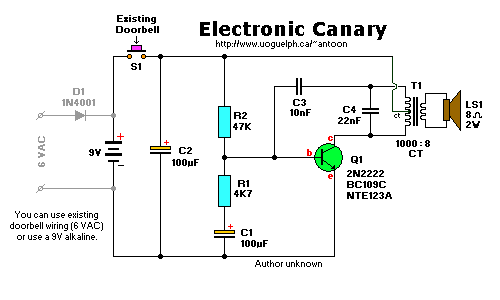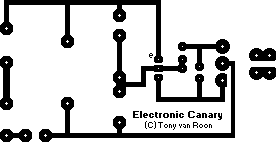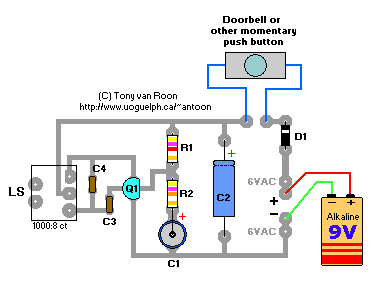
Parts List:
R1 = 4K7 (yellow-violet-red)
R2 = 47K (yellow-violet-orange)
C1 = 100uF, 16V, electrolytic
C2 = 100uF, 16V, electrolytic
C3 = 0.01uF (10NF or 103)
C4 = 0.022uF (22NF or 223)
Q1 = 2N2222 (or BC109C, NTE123A, PN100, etc)
D1 = 1N4001 (optional. Used only for 6VAC)
S1 = Your existing doorbell button
T1 = 1000:8 audio transformer, CT (LT700)
LS1 = Loudspeaker, 8 ohm, 2 Watts
Available as a kit. Click Here: [Canary Doorbell KIT]
Notes:
This circuit is a modified "Hartley Oscillator" with a couple extra parts. T1, the LT700 (or equivalent, is a small
center tapped (ct) audio transformer with an impedance of 1000 ohms at 1000 hertz. The secondary of this transformer
has an impedance of 8 ohms. Usually noted as 1K:8 ct. I tried a couple other models like the red and green types
(taken out of a $5 made-in-china am pocket radio) and they both work good. You may have to adjust the caps to get the
sound of your choice (e.i. faster/slower chirp).
The characteristic canary 'chirp' is produced by inclusion of R1 and C1. As the 100uF (C1) is charging up via the
R1 (4K7) resistor, the bias to Q1 is pinched off, which in return stops the Hartley from oscillating. When C1 is
ready, it discharges through the base/emitter of Q1 causing the oscillations to start again.
Use whatever you have. Just keep in mind that changing the value of any component, or the voltage, will change the
frequency of the chirp. At the press of the (doorbell) button, C1 is charged and the canary chirps. When the button
is released, the chirping decays and becomes faster until C1 is completely discharged. Click below to hear what it
sounds like.
You can use the existing doorbell houswiring, usually 6 VAC and adding a regualr 1N4001 diode, or use a 9 Volt
alkaline battery.
Click here to-==> listen to the Canary.


This circuit is not mine, I found it on the web many years ago but still a good oscillator learning circuit.
Credits and © copyright goes to the author. -Tony
Back to Circuits Page



